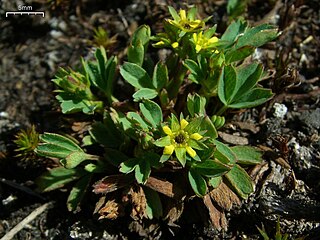
Rosaceae, the rose family, is a medium-sized family of flowering plants that includes 4,828 known species in 91 genera.

The rose subfamily Rosoideae consists of more than 850 species, including many shrubs, perennial herbs, and fruit plants such as strawberries and brambles. Only a few are annual herbs.

Dryas is a genus of perennial cushion-forming evergreen dwarf shrubs in the family Rosaceae, native to the arctic and alpine regions of Europe, Asia and North America. The genus is named after the dryads, the tree nymphs of ancient Greek mythology. The classification of Dryas within the Rosaceae has been unclear. The genus was formerly placed in the subfamily Rosoideae, but is now placed in subfamily Dryadoideae.

Cercocarpus, commonly known as mountain mahogany, is a small genus of at least nine species of nitrogen-fixing flowering plants in the rose family, Rosaceae. They are native to the western United States and northern Mexico, where they grow in chaparral and semidesert habitats and climates, often at high altitudes. Several are found in the California chaparral and woodlands ecoregion.

Purshia is a small genus of 5–8 species of flowering plants in the family Rosaceae which are native to western North America.

Pourthiaea is a genus of plants in the rose family (Rosaceae).
Johann August Carl Sievers (1762–1795) was a German-born botanist who explored Central Asia, Siberia, and other Asian regions of the Russian Empire. Among the species first described by Sievers is Malus sieversii, the ancestor of the domesticated apple. He died and was buried in Saint Petersburg.

Turgenia is a genus of flowering plants in the family Apiaceae, containing up to seven species. The genus resembles Caucalis. False carrot is a common name for plants in this genus.

Vahlodea is a monotypic genus of plants in the grass family. The only known species is Vahlodea atropurpurea(Wahlenb.) Fr.

Sibbaldia is a genus of flowering plants of the family Rosaceae, with a circumpolar distribution, including the high Arctic. Most of the species are found in the Himalaya. The type species is Sibbaldia procumbens. It is also in the Rosoideae subfamily.
Suchtelenia is a monotypic genus of flowering plant belonging to the family Boraginaceae. It only contains one known species, Suchtelenia calycina(C.A.Mey.) DC.
Komaroviopsis is a monotypic genus of flowering plants belonging to the family Apiaceae. It contains only one species, Komaroviopsis anisoptera, native to Uzbekistan in Central Asia.
Marcetella is a genus of flowering plants belonging to the family Rosaceae.
Sibbaldianthe is a genus of flowering plants belonging to the family Rosaceae. It is also in the Rosoideae subfamily.
Schulzia is a genus of flowering plants belonging to the family Apiaceae.
Schrenkia is a genus of flowering plants belonging to the family Apiaceae.
Przewalskia is a genus of flowering plants belonging to the family Solanaceae.
Potaninia is a monotypic genus of flowering plants belonging to the family Rosaceae. It only contains one known species, Potaninia mongolicaMaxim.
Kozlovia is a genus of flowering plants belonging to the family Apiaceae.

Kadenicarpus is a genus of flowering plants belonging to the family Cactaceae. It is native to eastern Mexico. It has been synonymized with Turbinicarpus but molecular phylogenetic studies have supported its monophyly and separation from that genus.










